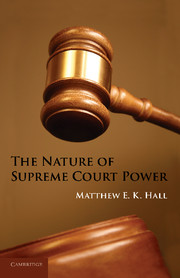Book contents
- Frontmatter
- Contents
- List of Figures
- List of Tables
- Preface
- 1 Neither Force, Nor Will
- 2 When Courts Command
- 3 Judging the Court
- 4 Popular Vertical Issues
- 5 Unpopular Vertical Issues
- 6 Popular Lateral Issues
- 7 Unpopular Lateral Issues
- 8 Neither the Sword nor the Purse, but the Keys
- Appendix I Case Selection
- Appendix II Survey Information and Citations
- Appendix III Supporting Data for Figures
- Appendix IV Statistical Analysis on the Effects of the Pico Ruling
- Appendix V Behavior Conformity Calculations
- Appendix VI Statistical Analysis of Behavior Conformity
- Appendix VII The Effects of Unanimity on Behavior Conformity
- Case References
- References
- Index
Appendix VI - Statistical Analysis of Behavior Conformity
Published online by Cambridge University Press: 06 December 2010
- Frontmatter
- Contents
- List of Figures
- List of Tables
- Preface
- 1 Neither Force, Nor Will
- 2 When Courts Command
- 3 Judging the Court
- 4 Popular Vertical Issues
- 5 Unpopular Vertical Issues
- 6 Popular Lateral Issues
- 7 Unpopular Lateral Issues
- 8 Neither the Sword nor the Purse, but the Keys
- Appendix I Case Selection
- Appendix II Survey Information and Citations
- Appendix III Supporting Data for Figures
- Appendix IV Statistical Analysis on the Effects of the Pico Ruling
- Appendix V Behavior Conformity Calculations
- Appendix VI Statistical Analysis of Behavior Conformity
- Appendix VII The Effects of Unanimity on Behavior Conformity
- Case References
- References
- Index
Summary
In Chapter 3, I hypothesize that the probability of the Supreme Court achieving high behavior conformity when issuing a ruling will increase when one of the following conditions has been met:
(1) The Court issues a ruling in a vertical issue area, or
(2) The Court issues a popular ruling in a lateral issue area.
However, the probability of the Court achieving high behavior conformity will decrease when:
(3) The Court issues an unpopular ruling in a lateral issue area.
This hypothesis can be formally stated as:
μi = α + β1lateral + β2lateral × popularity + ε
where μ is the average behavior conformity, α is a constant, lateral is an indicator variable for lateral issues, lateral × popularity is an interaction term between an indicator variable for lateral issues and a trichotomous indicator variable indicating the popularity of the Court's ruling, β1 and β2 are coefficients for the effects of these two variables, and ε is the unobserved disturbance. I code the trichotomous indicator variable as 1 if less than 30 percent of respondents in national public opinion surveys indicate opposition to the Court's ruling; as 0 if more than 70 percent of respondents indicate opposition, and as 0.5 otherwise. For those Supreme Court cases in which no national public opinion poll was conducted, I assume the Court faces little public opposition and code the trichotomous indicator variable as 1.
- Type
- Chapter
- Information
- The Nature of Supreme Court Power , pp. 221 - 224Publisher: Cambridge University PressPrint publication year: 2010



